Best Way to Secure a Floating Dock: Expert Tips for Safety & Stability
If you’re a waterfront property owner, boater, or marina operator, you’ve probably wondered about the best way to secure a floating dock. Floating docks are popular because they’re convenient, flexible, and adapt to changing water levels. However, without proper anchoring and stabilization, they can drift away, get damaged, or create safety risks. Securing your dock the right way ensures both safety and long-term stability for everyone who uses it.
Why Securing a Floating Dock Is Important
Unlike fixed docks, floating docks rise and fall with water levels. While this makes them ideal for lakes, rivers, and coastal areas, it also means they need reliable anchoring to prevent unwanted movement. Without proper security:
- Storms and high winds can push the dock away from its position.
- Strong currents may cause the dock to drift or rotate.
- Boats and equipment tied to the dock could suffer damage.
- Safety risks increase for swimmers, boaters, and anyone accessing the dock.
A well-secured dock not only protects your investment but also ensures that it remains safe to use in all seasons.
Best Ways to Secure a Floating Dock
1. Use Anchoring Systems
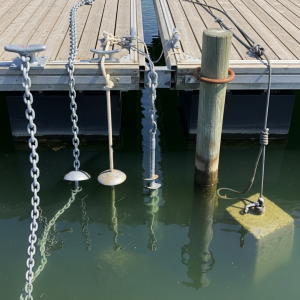
Anchoring is the most common and reliable way to keep a floating dock stable. The type of anchor you choose depends on water depth and bottom conditions:
- Deadweight Anchors – These are heavy concrete blocks or weights that rest on the lake or riverbed. Their sheer mass prevents the dock from moving. They work best in deep water with stable bottoms.
- Piling Anchors – Vertical posts driven deep into the ground keep the dock aligned. The dock is attached with hoops or rollers, allowing vertical movement with water levels while holding it securely in place.
- Auger Anchors – These screw into the lake or riverbed, offering excellent grip in sandy or muddy bottoms. They provide a strong hold without needing massive weights.
2. Shore Attachments
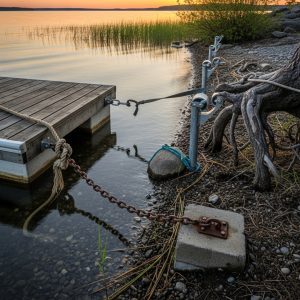
Attaching one end of your dock to the shoreline provides extra stability. This can be done with shore anchors, cables, or ramps. By anchoring to the land, you reduce side-to-side movement, especially in windy or high-current areas.
3. Cable & Chain Systems
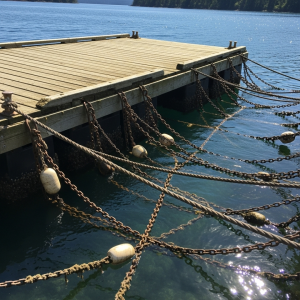
For additional strength, heavy-duty cables or chains can be used to connect the dock to shore or underwater anchor points. Always choose stainless steel or galvanized materials, since they resist corrosion in wet environments and extend the life of your setup.
4. Gangways and Ramps
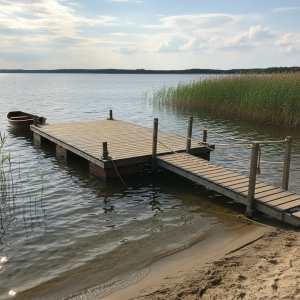
Adding a gangway not only improves accessibility but also strengthens your dock’s structure. A properly designed gangway acts as a stabilizing arm, holding the dock in place while allowing for flexibility with water level changes.
5. Consider Environmental Factors
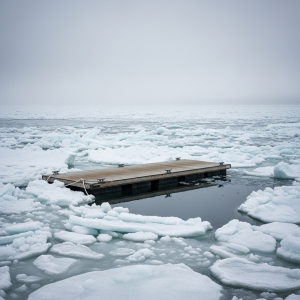
Every dock location is different. Take into account:
- Water depth – Deeper areas may require heavier anchors or longer chains.
- Current strength – Stronger currents demand more secure anchoring systems.
- Wind exposure – Open areas prone to gusts need reinforced attachments.
- Seasonal changes – In colder regions, ice can damage docks if not removed or repositioned.
Expert Tips for Maximum Safety & Stability
- Inspect Regularly – Check chains, cables, and anchors at least once per season for wear, rust, or weakness.
- Choose Quality Materials – Invest in marine-grade hardware designed to withstand harsh weather and constant water exposure.
- Allow Flexibility – A good system allows slight movement with waves and currents. Rigid docks are more likely to suffer structural damage.
- Adjust for Seasons – In winter climates, remove your dock or move it to deeper water to avoid ice damage.
- Get Professional Help – For larger docks or commercial marinas, professional installation ensures everything is properly anchored and compliant with local regulations.
Final Thoughts
When it comes to the best way to secure a floating dock, the right solution depends on your location, water conditions, and dock size. Anchors, cables, piling systems, and gangways can all work effectively when chosen correctly and maintained regularly. The goal is to keep your dock stable enough for safe use while allowing it to move naturally with changing water levels.
By following these expert tips and using durable materials, you can keep your dock safe, secure, and enjoyable for years to come. For homeowners, marinas, and businesses looking for dependable solutions, Dockstop offers top-quality products and expertise to ensure your floating dock is both safe and stable no matter the conditions.
